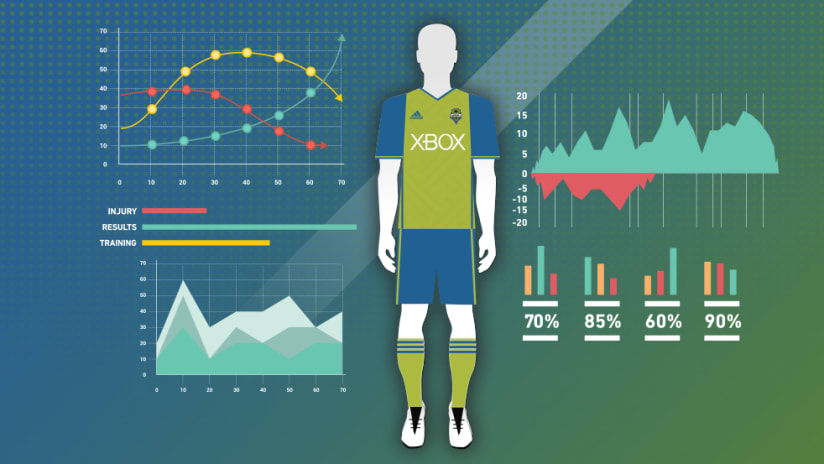Clint Dempsey shuffles toward the sideline at Starfire Sports Complex, another training session in the books. Before the Seattle Sounders’ Designated Player heads back to the locker room, he pulls off the harness wrapped around his chest and drops it off with the training staff. If you didn’t know better, you might think Dempsey was training in a sports bra.
But the harnesses aren’t for support, and they certainly aren’t sports bras. They hold the heart-rate monitors and GPS trackers that are strapped to Dempsey his teammates every day during training, spitting out a mountain of real-time and historical data that gives Dave Tenney, the club’s manager of performance and sports science, and his staff a window into each player’s fitness, fatigue and injury risk.
That data flows into the in-house platform that former Microsoft employee and, since 2012, Sounders’ sports science data analyst Ravi Ramineni built to turn GPS coordinates and heart-rate fluctuations into actionable reports. The goal? To maximize each player’s output, giving Seattle’s coaching staff a foundation to put a winning product on the field.
“It’s almost like a risk portfolio that you are managing,” Ramineni says. “You have a final goal of what you want to achieve and then you have to weigh all these factors with the risk.”
Tenney recruited Ramineni, a Clemson-trained computer scientist and long-time soccer nut, four years ago as he set about building what is arguably the strongest sports science department in MLS. The Sounders’ sports science staff now includes seven employees.
Thanks to the terabytes of data Tenney’s staff gathers during every training session and game, the Sounders are able to put together individualized programs to help players avoid injuries and perform at their best. And since Seattle have been collecting data since their expansion season in 2009, they now have nearly seven years of data with which to monitor the physical performance of stalwarts such as Osvaldo Alonso and Brad Evans.
They now have nearly three years of data on Dempsey as well, which helps the coaching staff manage the game minutes, training load and injury risk for the face of the franchise. That risk, as Ramineni alluded to, is of primary concern to the club. In order to meet their goals on the field, the staff must ensure players are prepared for and can safely endure the unique challenges that come with playing in MLS.
“You’ve got the level of travel, the different surfaces you play on, the different temperatures you play in,” Tenney says. “It’s a challenge to players that come from overseas that don’t see a lot of change. Being able to measure guys coming out of a game gives a good snapshot of how that guy might tolerate training or may be at risk the next week.”
Tenney and his staff use a variety of tools to determine the probability of injury and account for age, injury history and various tests such as the Nordbord, which measures hamstring strength, to give head coach Sigi Schmid and his staff an idea who might be at risk as the season progresses and wear and tear accumulates on each player.
Sometimes that means reining at-risk players in during training. In Dempsey’s case, that’s sometimes meant scaling back his minutes after taxing United States national team camps, as the Sounders did following the Gold Cup last season. Tenney and his staff present their findings, but the final decision is made by the coaching staff, who must balance potential injury with the chase for points and a playoff place.
“We try to get the process of decision-making as foolproof as possible, but nobody can make perfect decisions,” Ramineni says. “If you followed the same process to make the decision all the time and if as an organization you follow the same process to make your decision, more often than not you will get it right.”
But Tenney’s job isn’t just to tell the coaching staff when a player has had enough. Sometimes players need to be pushed to in order to reach peak performance.
“Using sports science to reduce injuries [is] not always about training less or looking at at-risk guys, it’s also about knowing when guys need to train hard,” he says. “How do you use the technology to know when’s the right time to push guys and have the athletes be okay to be pushed?”
Of course, not all athletes are built the same way and not all positions require the same workload. Central midfielders are required to accelerate and decelerate many times throughout a match, while fullbacks must be able to make repeated long-distance sprints.
Tenney and his team account for those discrepancies when they help the coaching staff put together their training sessions. This often means adding extra activities for specific players based on their positional needs or tailoring drills to meet each positional need.
It’s also where real-time data collection comes into play.
“A lot of times when you work on some strict tactical ideas in training your central defenders might not work as hard as they need to,” Tenney explains. “I can say to Chad [Marshall], ‘You didn’t run today, let’s do a few sprints, let’s do a few accelerations or striders to try to get the load you need because today was supposed to be a heavy day.’”
As the stakes get higher and higher, Tenney expects investment in sports science to grow, as it has abroad and in other US-based sports leagues. Boiled down to basics, MLS teams must keep their players – in other words, their competitive portfolio – on the field and performing to the peak of their abilities in order to compete.
“In this field, if you stand still,” Ramineni says, “people will pass you by.”








